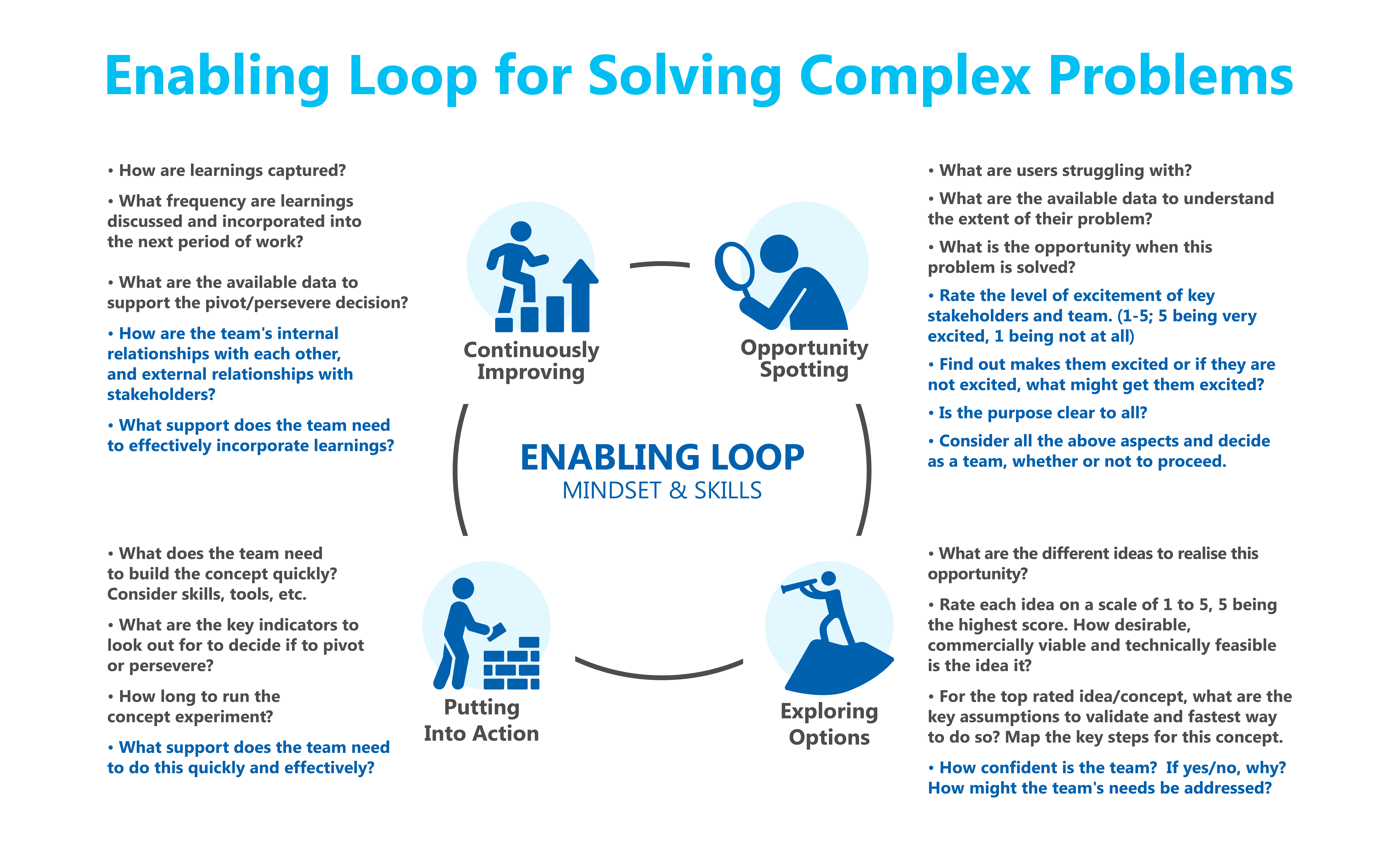Overview
The Enabling Loop is a holistic guide for solving complex problems, be it in product development, operations or business support functions. It is relevant in today’s volatility, uncertainty, complexity, and ambiguity based (VUCA) world, as traditional problem-solving methods no longer suffice for creating great products and user experiences.
As teams and organisations encounter more complex problems, an adaptive mindset and varied skillsets are needed to be more sharply attuned to users. This applies to developing a new product, rejuvenating an existing one or reimagining day-to-day operations. Being able to effectively spot opportunities and develop more creative, value-added solutions are key for every organisation to stay at the top of their game.
Objective
The Enabling Loop guide aims to help leaders, product owners and teams resist the temptation to jump straight into solution mode when confronted with a problem – It enables an effective evaluation of whether a problem is worth solving first and its complexity, before investing further effort to develop a solution- or determine if further enhancements are required.
The conscious use of the Enabling Loop enables teams and organisations to deliver value in a timelier manner, through effective solutions that harness the right opportunities by solving the right problems.
Scope
The Enabling Loop guide and canvas is applicable for creating and managing products – whether it is conceptualising new products, maintaining or enhancing existing products, or improving daily operations and business support functions - and is not confined to problems that require digital solutions.
Target Audience and Adoption Criteria
The Enabling Loop is a good practice guideline that is useful to the following user groups:
- Leaders who govern and/or influence the suite of product offerings and the product strategies in their organisations
- Product owners
- Product teams
- Project teams
- Operations staff or teams
- Staff in business support functions such as finance, HR, procurement, etc.
Standards, Guidelines and Assessment Criteria
The Enabling Loop includes a set of questions that can be easily worked through. These questions are based on the appreciative inquiry approach and applying an agile mindset with a human-centred focus to deliver valuable outcomes. The questions can be applied when starting on a newly approved project, in product development or an initiative. It can also be useful for supporting decision-making and ensuring that the work is more purpose-driven than feature-driven.
Although the Enabling Loop is based on the classic design-thinking approach, key elements of systems thinking inspired by the PERILL Model for leadership and team coaching, have been incorporated. When using the guide’s questions to solve complex problems, there is an added benefit of helping to jumpstart the building of strong, capable teams.
The key steps of the Enabling Loop are to:
- Spot the Opportunity
- Understand the problems that users have, how they are coping, and use the available data to determine the severity of the problem and whether it is worth solving
- Discuss the potential opportunities and benefits to users, teams, and organisations
- Understand from stakeholders and teams on how keen they feel about solving the problem and why
- Explore the Options
- Ideate possible options to solve the problem and evaluate them
- For the top-rated option (concept), determine the key assumptions and formulate an hypothesis to test
- Determine what the indicators might be to know whether to initiate change or persevere when there is user feedback
- Find out from the team how confident it is to solve the problem and why
- Put to Action
- Determine the fastest way to easily build and test the concept (carry out the experiment)
- Find out what the team’s needs are – either internally or externally - to carry out the experiment quickly and effectively
- Measure the outcomes according to the indicators identified under Step 2 “(Exploring the Options)”
- Improve Continuously
- Find out how the team feels at the end of the experiment – their morale level, what works and what additional support and/or improvements might be needed
- Determine which improvements to incorporate into the next cycle or if it is better to abort the experiment and revisit earlier steps (e.g. Spot the Opportunities, Explore the Options or Put to Action).

While these seem to take place (and are often visualised) in a sequential flow, it is meant to be practised in iterations – A data-based decision at each step might sometimes mean that previous steps need to be revisited. Often, teams may be required to re-establish the problem or to validate assumptions that were previously overlooked.
Contact Information
For enquiries on the Enabling Loop, please contact:
Regina Ong regina_ong@tech.gov.sg
Debbie Siah debbie_siah@tech.gov.sg
Last updated 18 September 2023
Thanks for letting us know that this page is useful for you!
If you've got a moment, please tell us what we did right so that we can do more of it.
Did this page help you? - No
Thanks for letting us know that this page still needs work to be done.
If you've got a moment, please tell us how we can make this page better.

